Launch – Hello Amazon Macie: Automatically Discover, Classify, and Secure Content at Scale
When Jeff and I heard about this service, we both were curious on the meaning of the name Macie. Of course, Jeff being a great researcher looked up the name Macie and found that the name Macie has two meanings. It has both French and English (UK) based origin, it is typically a girl name, has various meanings. The first meaning of Macie that was found, said that that name meant “weapon”. The second meaning noted the name was representative of a person that is bold, sporty, and sweet. In a way, these definitions are appropriate, as today I am happy to announce that we are launching Amazon Macie

Amazon Macie is a service powered by machine learning that can automatically discover and classify your data stored in Amazon S3. But Macie doesn’t stop there, once your data has been classified by Macie, it assigns each data item a business value, and then continuously monitors the data in order to detect any suspicious activity based upon access patterns. Key features of the Macie service include:
- Data Security Automation: analyzes, classifies, and processes data to understand the historical patterns, user authentications to data, data access locations, and times of access.
- Data Security & Monitoring: actively monitors usage log data for anomaly detected along with automatic resolution of reported issues through CloudWatch Events and Lambda
- Data Visibility for Proactive Loss prevention: Provides management visibility into details of storage data while providing immediate protection without the need for manual customer input
- Data Research and Reporting: allows administrative configuration for reporting and alert management requirements
How does Amazon Macie accomplish this you ask?
Using machine learning algorithms for natural language processing (NLP), Macie can automate the classification of data in your S3 buckets. In addition, Amazon Macie takes advantage of predictive analytics algorithms enabling data access patterns to be dynamically analyzed. Learnings are then used to inform and to alert you on possible suspicious behavior. Macie also runs an engine specifically to detect common sources of personally identifiable information (PII), or sensitive personal information (SP). Macie takes advantage of AWS CloudTrail and continuously checks Cloudtrail events for PUT requests in S3 buckets and automatically classify new objects in almost real time.
While Macie is a powerful tool to use for security and data protection in the AWS cloud, it also can aid you with governance, compliance requirements, and/or audit standards. Many of you may already be aware of the EU’s most stringent privacy regulation to date – The General Protection Data Regulation (GDPR), which becomes enforceable on May 25, 2018. As Amazon Macie recognizes personally identifiable information (PII) and provides customers with dashboards and alerts, it will enable customers to comply with GDPR regulations around encryption and pseudonymization of data. When combined with Lambda queries, Macie becomes a powerful tool to help remediate GDPR concerns.
Tour of the Amazon Macie Service
Let’s look a tour of the service and look at Amazon Macie up close and personal.
First, I will log onto the Macie console and start the process of setting up Macie so that I can start to my data classification and protection by clicking the Get Started button.
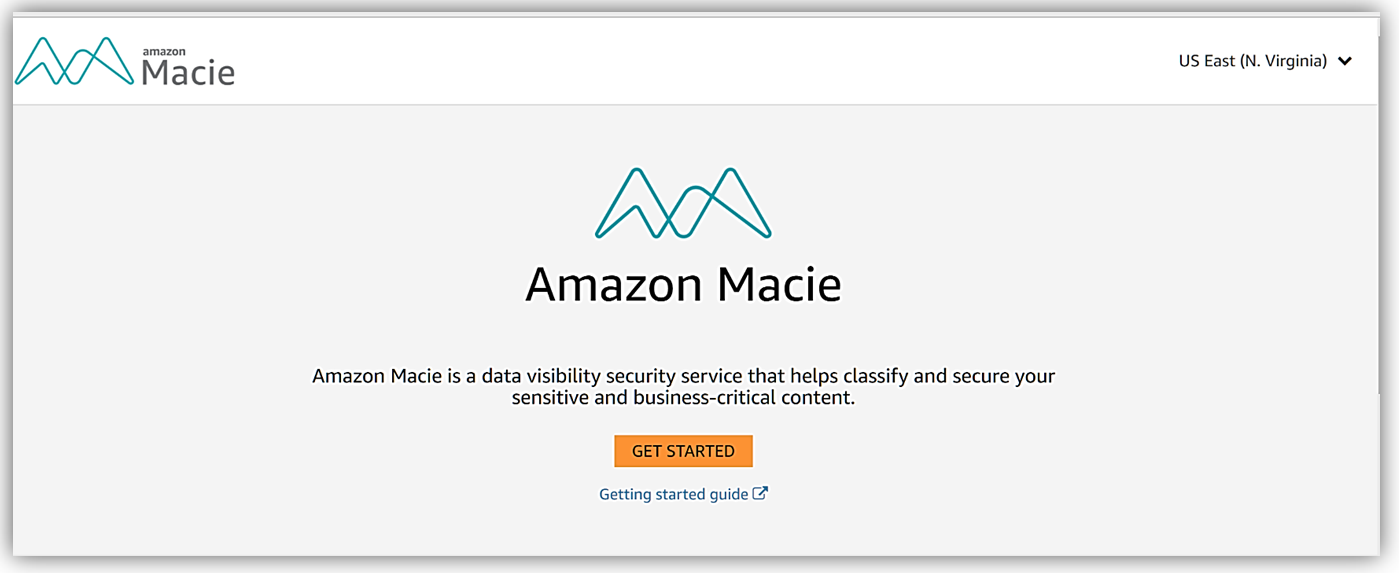
As you can see, to enable the Amazon Macie service, I must have the appropriate IAM roles created for the service, and additionally I will need to have AWS CloudTrail enabled in my account.
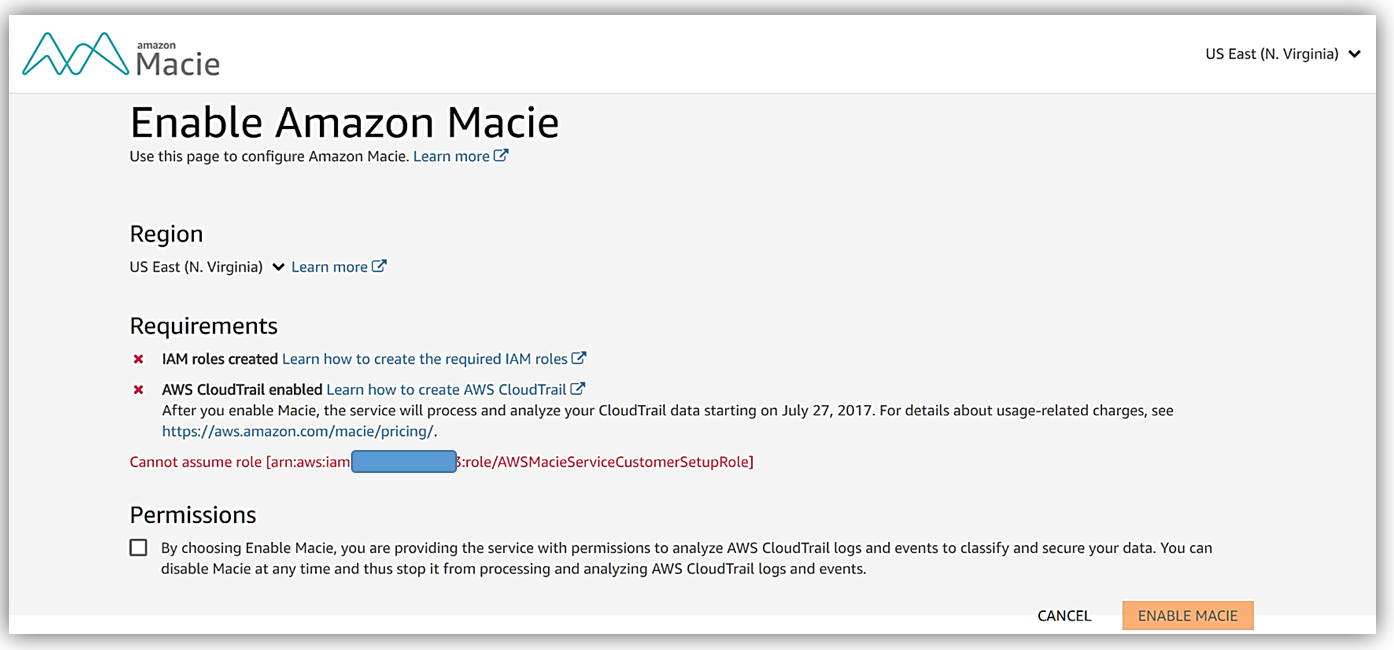
I will create these roles and turn on the AWS CloudTrail service in my account. To make things easier for you to setup Macie, you can take advantage of sample template for CloudFormation provided in the Macie User Guide that will set up required IAM roles and policies for you, you then would only need to setup a trail as noted in the CloudTrail documentation.
If you have multiple AWS accounts, you should note that the account you use to enable the Macie service will be noted as the master account, you can integrate other accounts with the Macie service but they will have the member account designation. Users from member accounts will need to use an IAM role to federate access to the master account in order access the Macie console.
Now that my IAM roles are created and CloudTrail is enabled, I will click the Enable Macie button to start Macie’s data monitoring and protection.
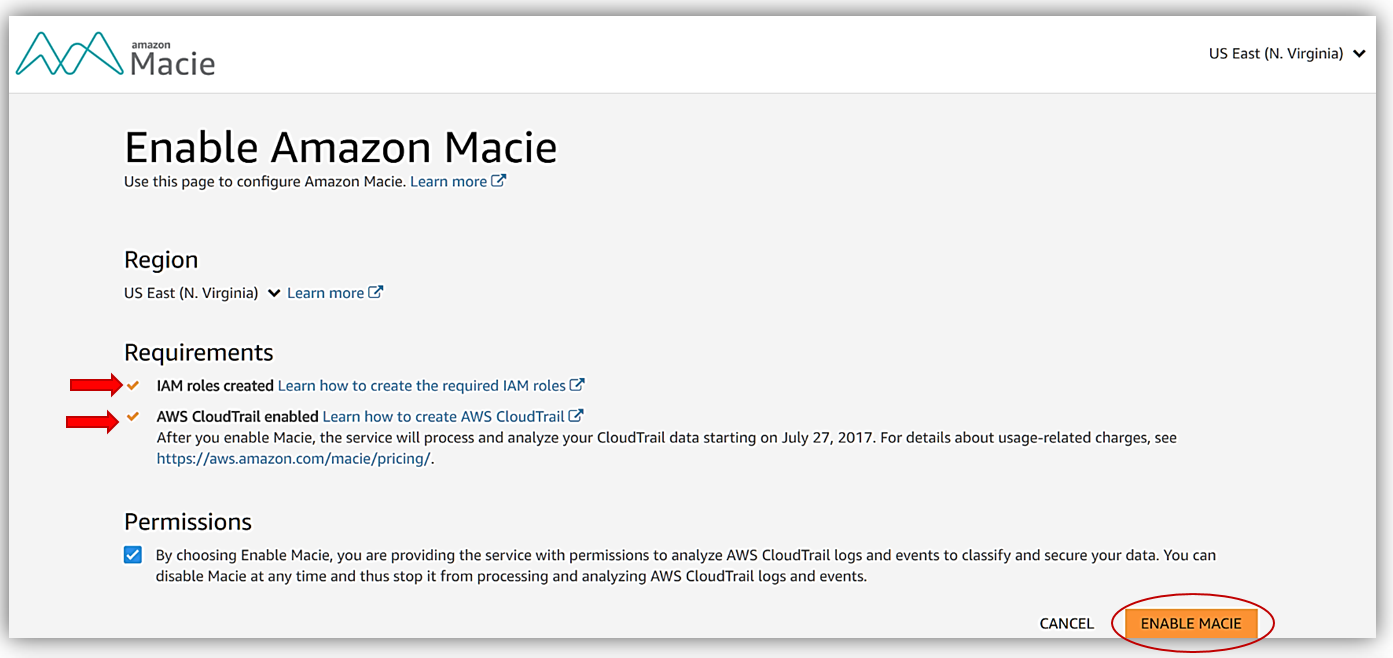

Once Macie is finished starting the service in your account, you will be brought to the service main screen and any existing alerts in your account will be presented to you. Since I have just started the service, I currently have no existing alerts at this time.
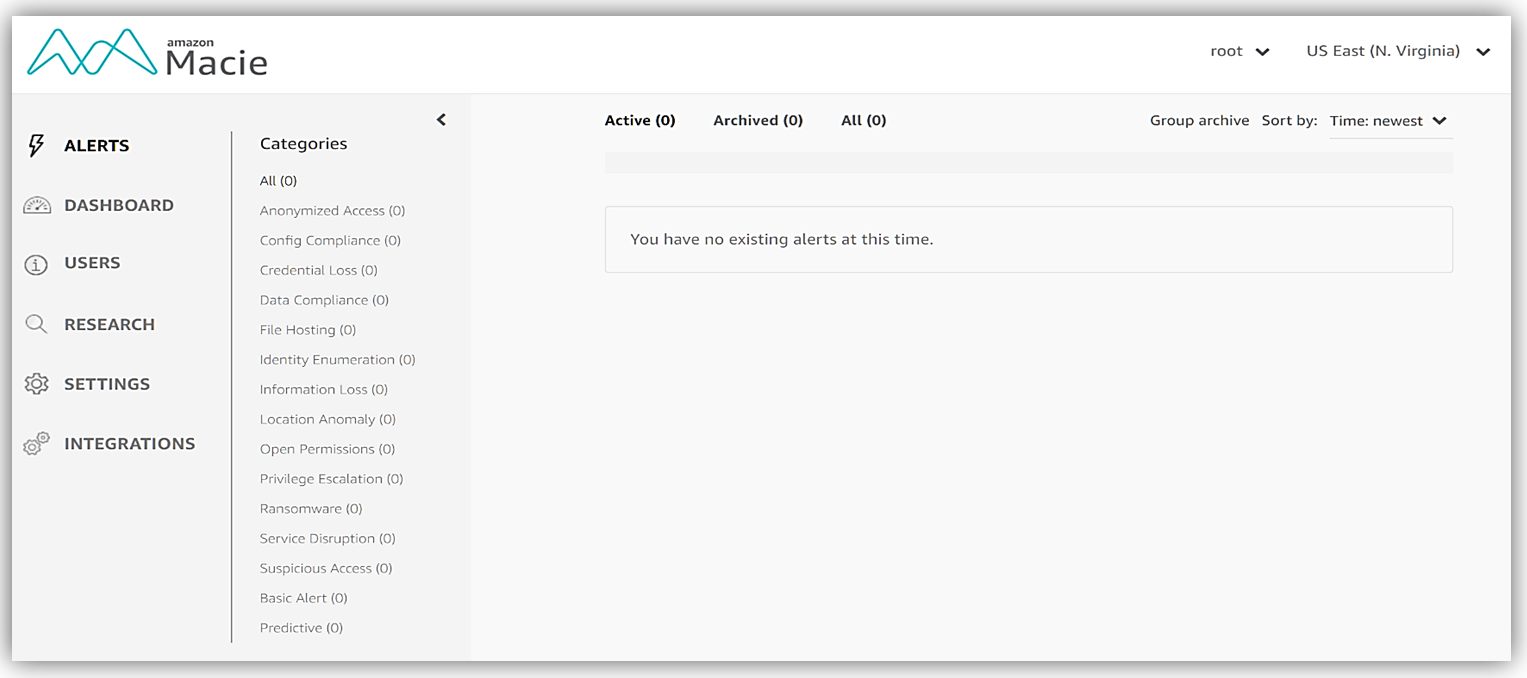
Considering we are doing a tour of the Macie service, I will now integrate some of my S3 buckets with Macie. However, you do not have to specify any S3 buckets for Macie to start monitoring since the service already uses the Management API analyze and process information. With this tour of Macie, I have decided to monitor some object level API events in from certain buckets in CloudTrail.
In order to integrate with S3, I will go to the Integrations tab of the Macie console. Once on the Integrations tab, I will see two options: Accounts and Services. The Account option is used to integrate member accounts with Macie and to set your data retention policy. Since I want to integrate specific S3 buckets with Macie, I’ll click the Services option go to the Services tab.
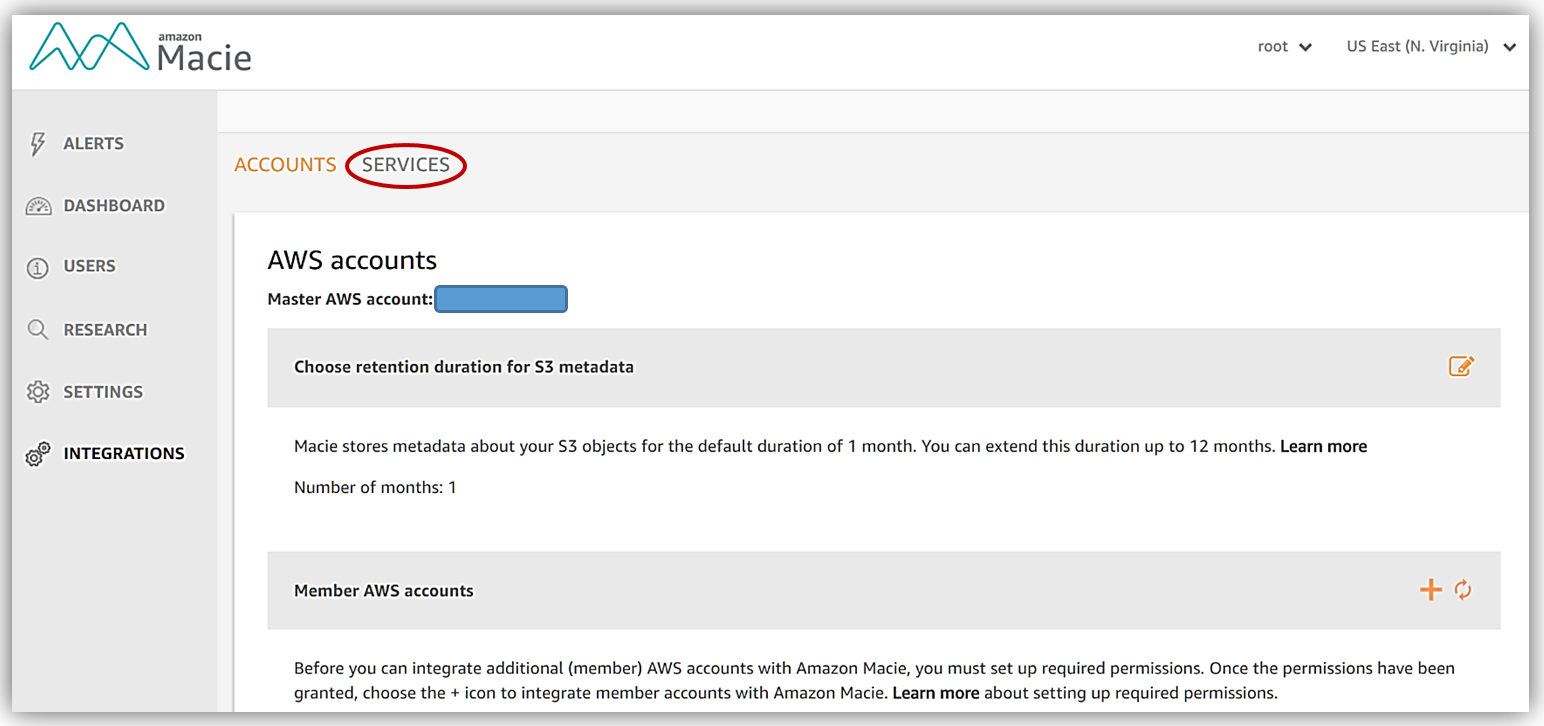
When I integrate Macie with the S3 service, a trail and a S3 bucket will be created to store logs about S3 data events. To get started, I will use the Select an account drop down to choose an account. Once my account is selected, the services available for integration are presented. I’ll select the Amazon S3 service by clicking the Add button.
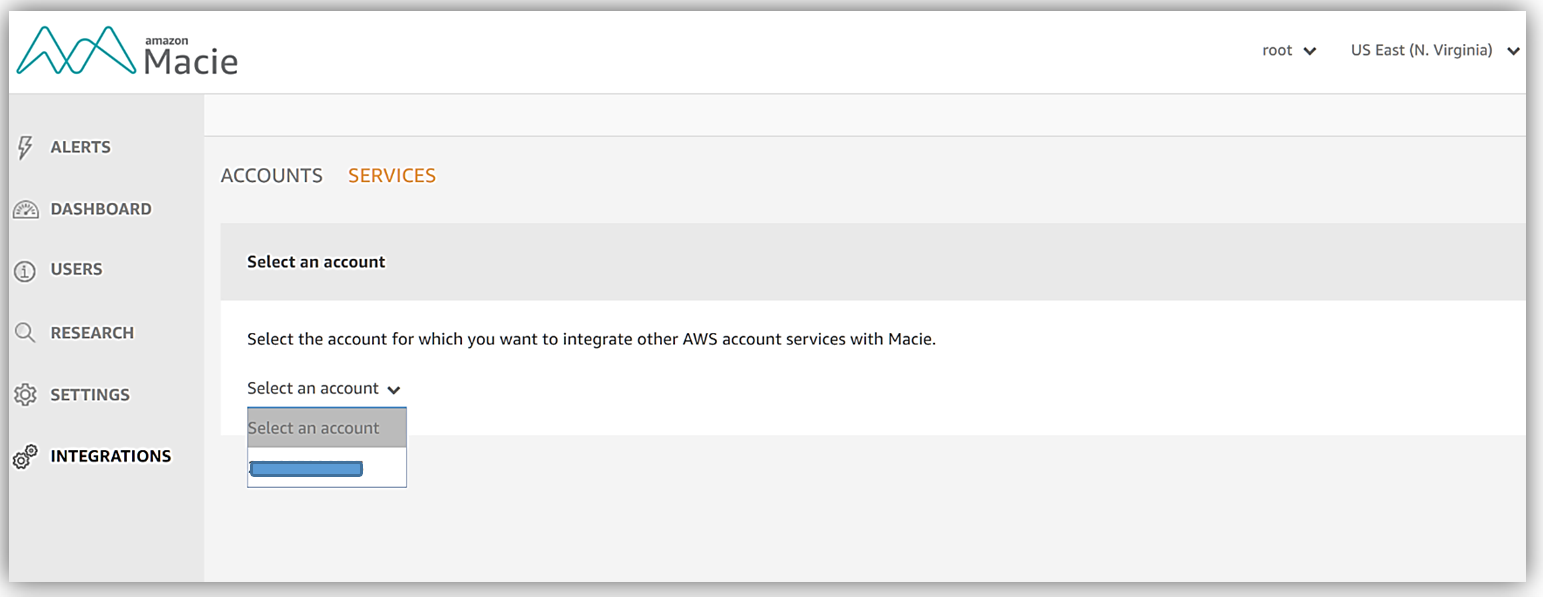
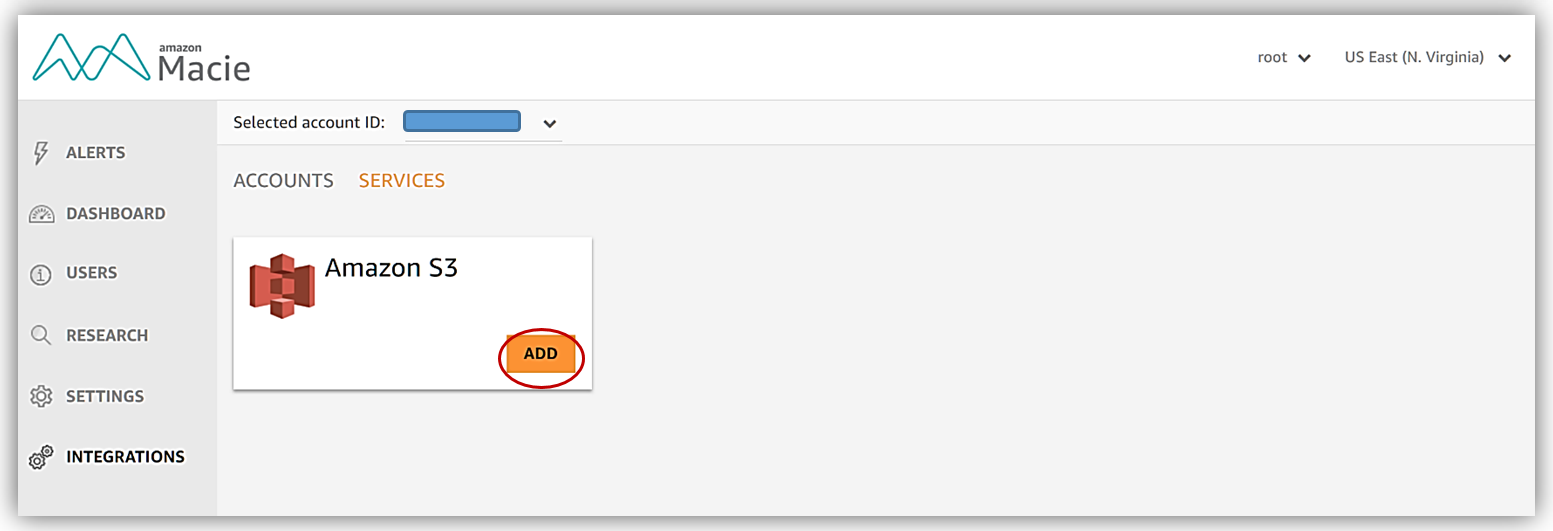
Now I can select the buckets that I want Macie to analyze, selecting the Review and Save button takes me to a screen which I confirm that I desire object level logging by clicking Save button.
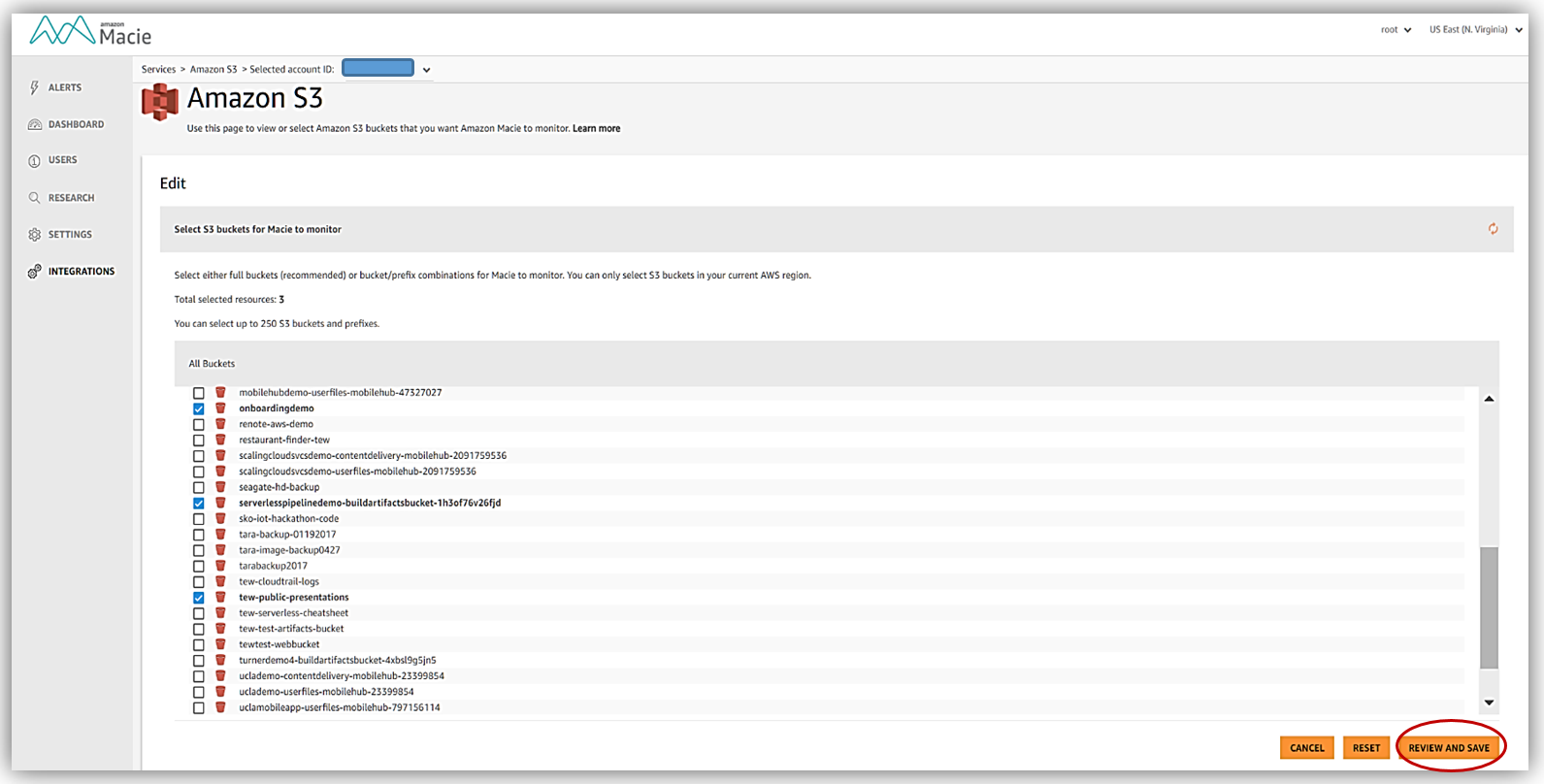
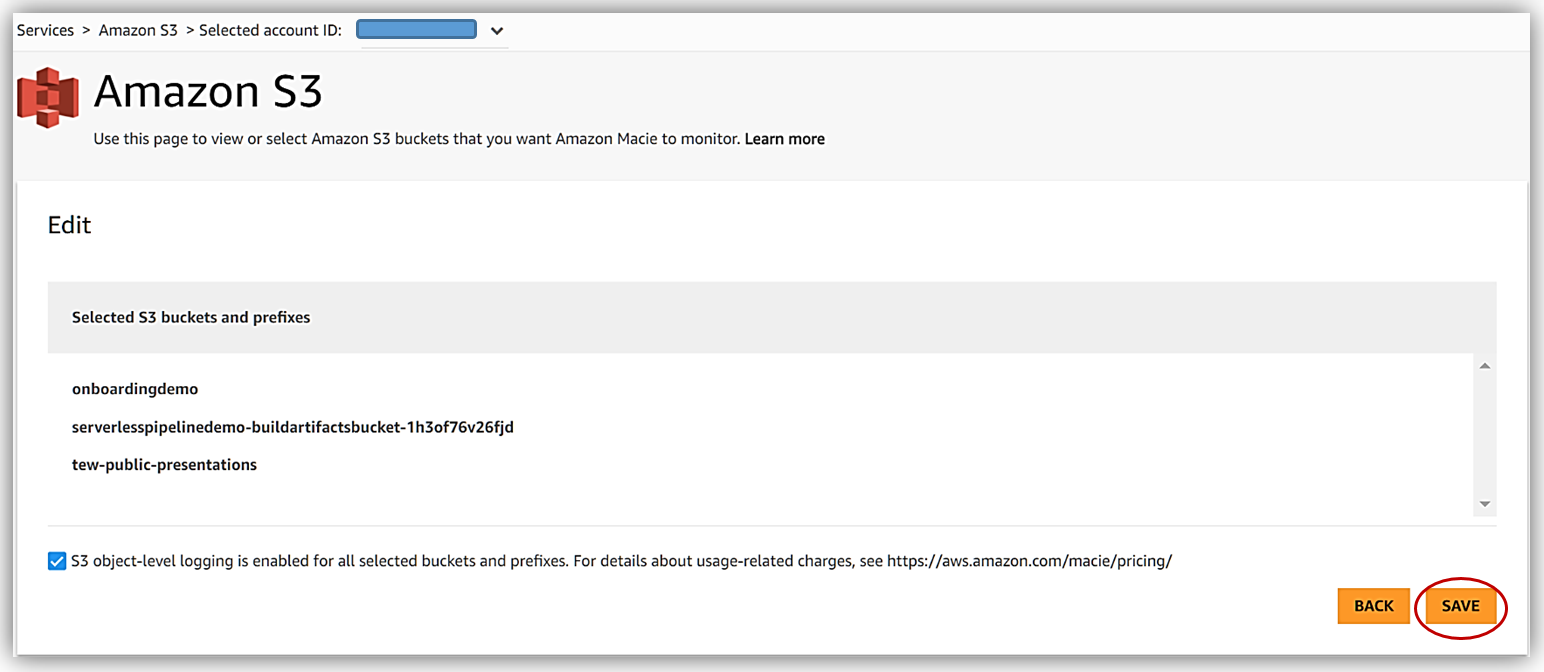
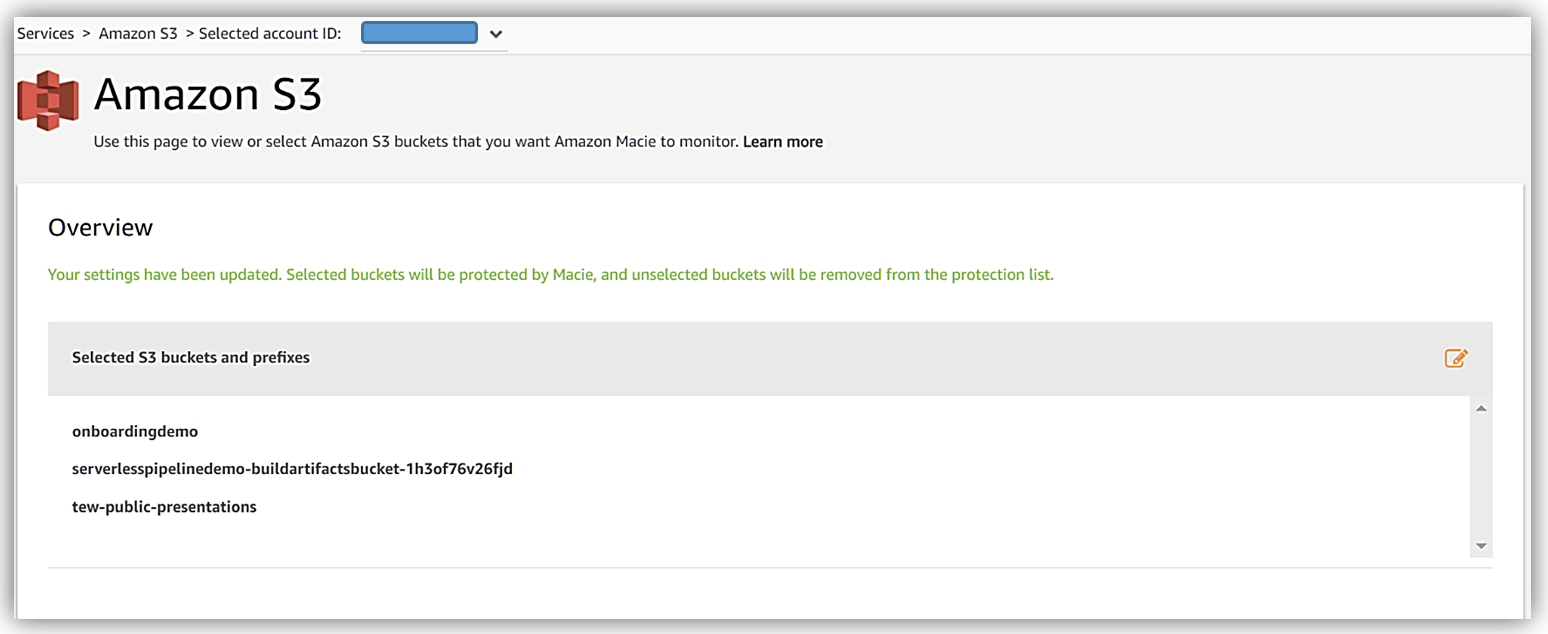 4
4
Next, on our Macie tour, let’s look at how we can customize data classification with Macie.
As we discussed, Macie will automatically monitor and classify your data. Once Macie identifies your data it will classify your data objects by file and content type. Macie will also use a support vector machine (SVM) classifier to classify the content within S3 objects in addition to the metadata of the file. In deep learning/machine learning fields of study, support vector machines are supervised learning models, which have learning algorithms used for classification and regression analysis of data. Macie trained the SVM classifier by using a data of varying content types optimized to support accurate detection of data content even including the source code you may write.
Macie will assign only one content type per data object or file, however, you have the ability to enable or disable content type and file extensions in order to include or exclude them from the Macie service classifying these objects. Once Macie classifies the data, it will assign risk level of the object between 1 and 10 with 10 being the highest risk and 1 being the lowest data risk level.
To customize the classification of our data with Macie, I’ll go to the Settings Tab. I am now presented with the choices available to enable or disable the Macie classifications settings.

For an example during our tour of Macie, I will choose File extension. When presented with the list of file extensions that Macie tracks and uses for classifications.
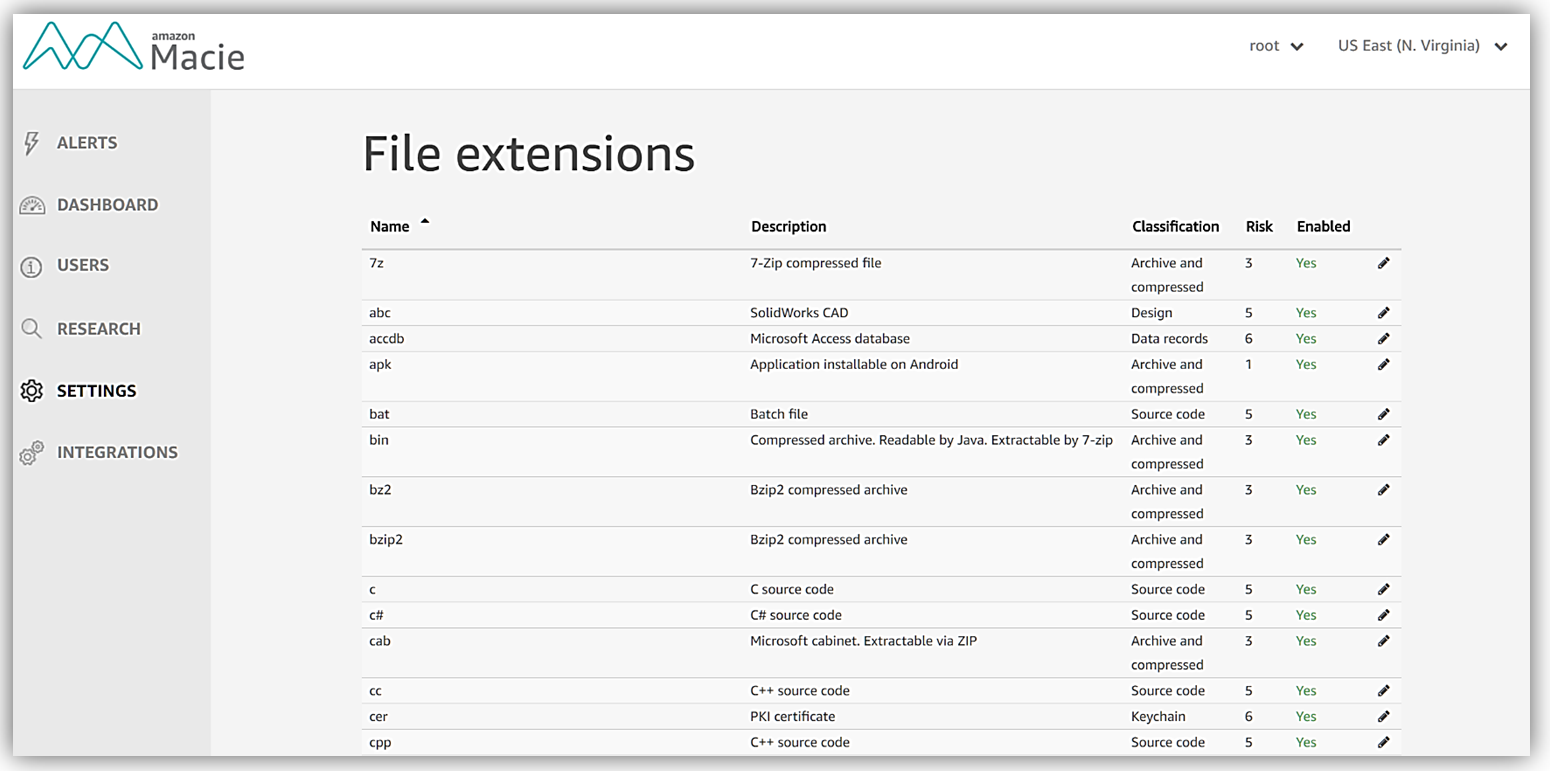
As a test, I’ll edit the apk file extension for Android application install file, and disable monitoring of this file by selecting No – disabled from the dropdown and clicking the Save button. Of course, later I will turn this back on since I want to keep my entire collection of data files safe including my Android development binaries.
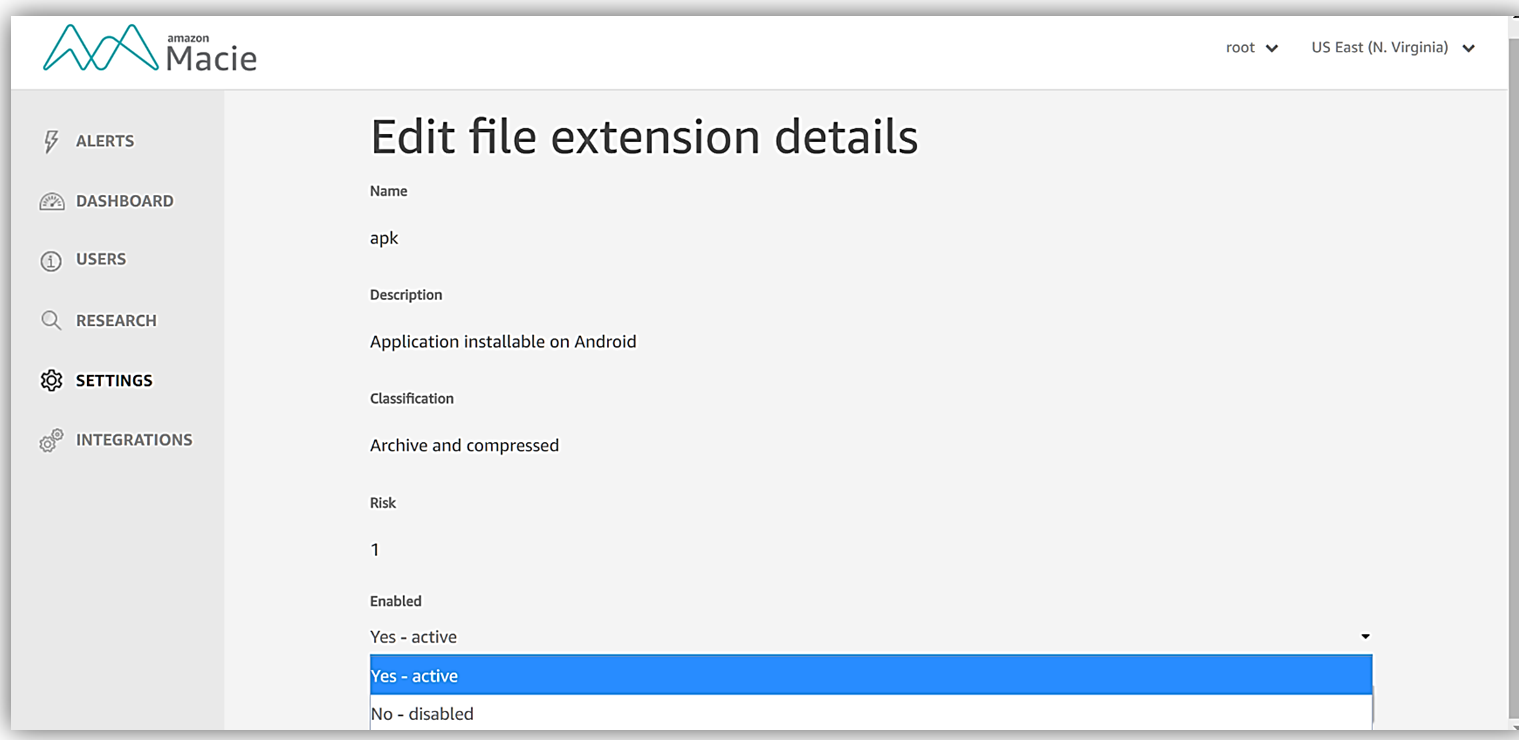
One last thing I want to note about data classification using Macie is that the service provides visibility in how you data object are being classified and highlights data assets that you have stored regarding how critical or important the information for compliance, for your personal data and for your business.
Now that we have explored the data that Macie classifies and monitors, the last stop on our service tour is the Macie dashboard.
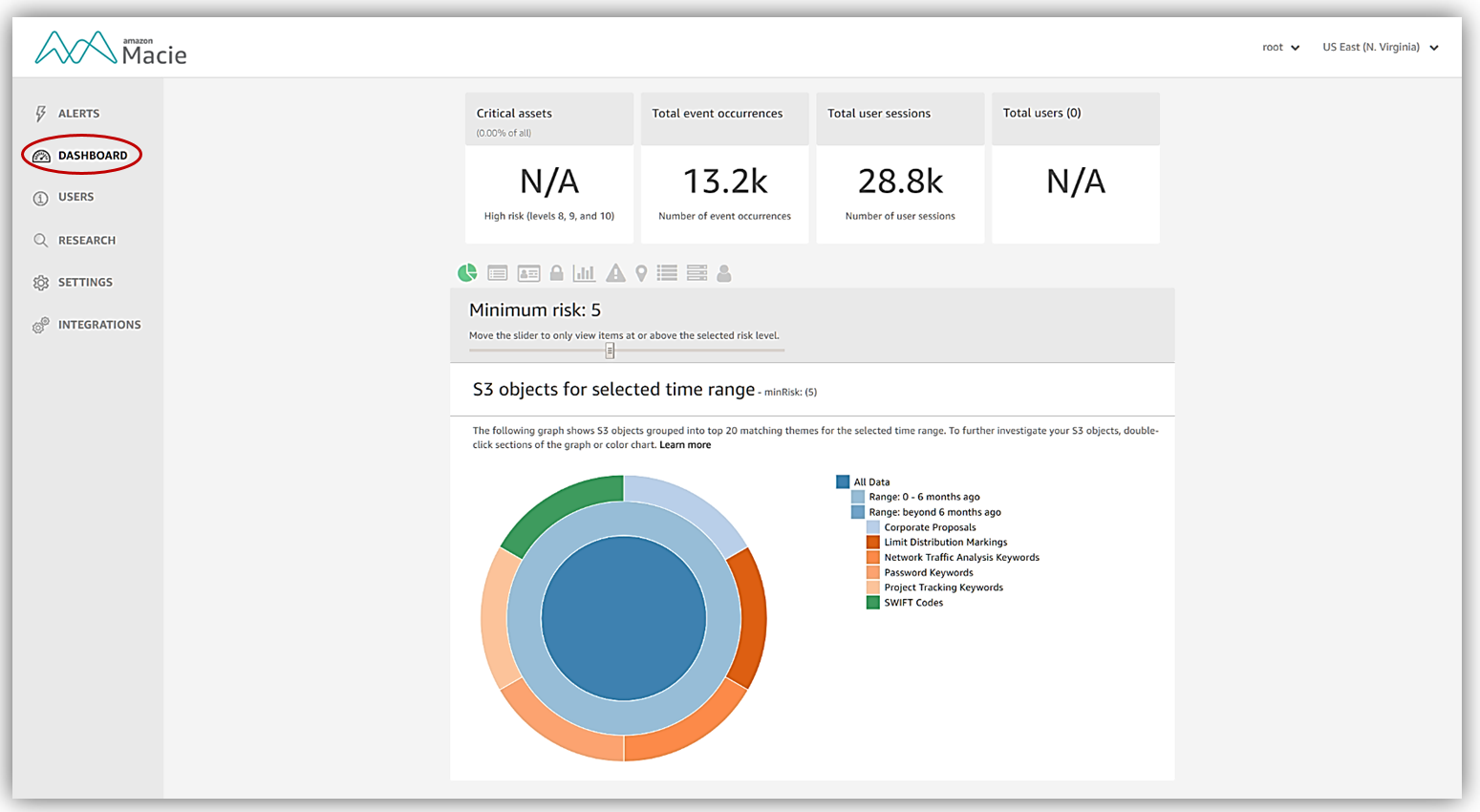
The Macie Dashboard provides us with a complete picture of all of the data and activity that has been gathered as Macie monitors and classifies our data. The dashboard displays Metrics and Views grouped by categories to provide different visual perspectives of your data. Within these dashboard screens, you also you can go from a metric perspective directly to the Research tab to build and run queries based on the metric. These queries can be used to set up customized alerts for notification of any possible security issues or problems. We won’t have an opportunity to tour the Research or Alerts tab, but you can find out more information about these features in the Macie user guide.
Turning back to the Dashboard, there are so many great resources in the Macie Dashboard that we will not be able to stop at each view, metric, and feature during our tour, so let me give you an overview of all the features of the dashboard that you can take advantage of using.
Dashboard Metrics – monitored data grouped by the following categories:
- High-risk S3 objects: data objects with risk levels of 8 through 10.
- Total event occurrences: – total count of all event occurrences since Macie was enabled
- Total user sessions – 5-minute snapshot of CloudTrail data
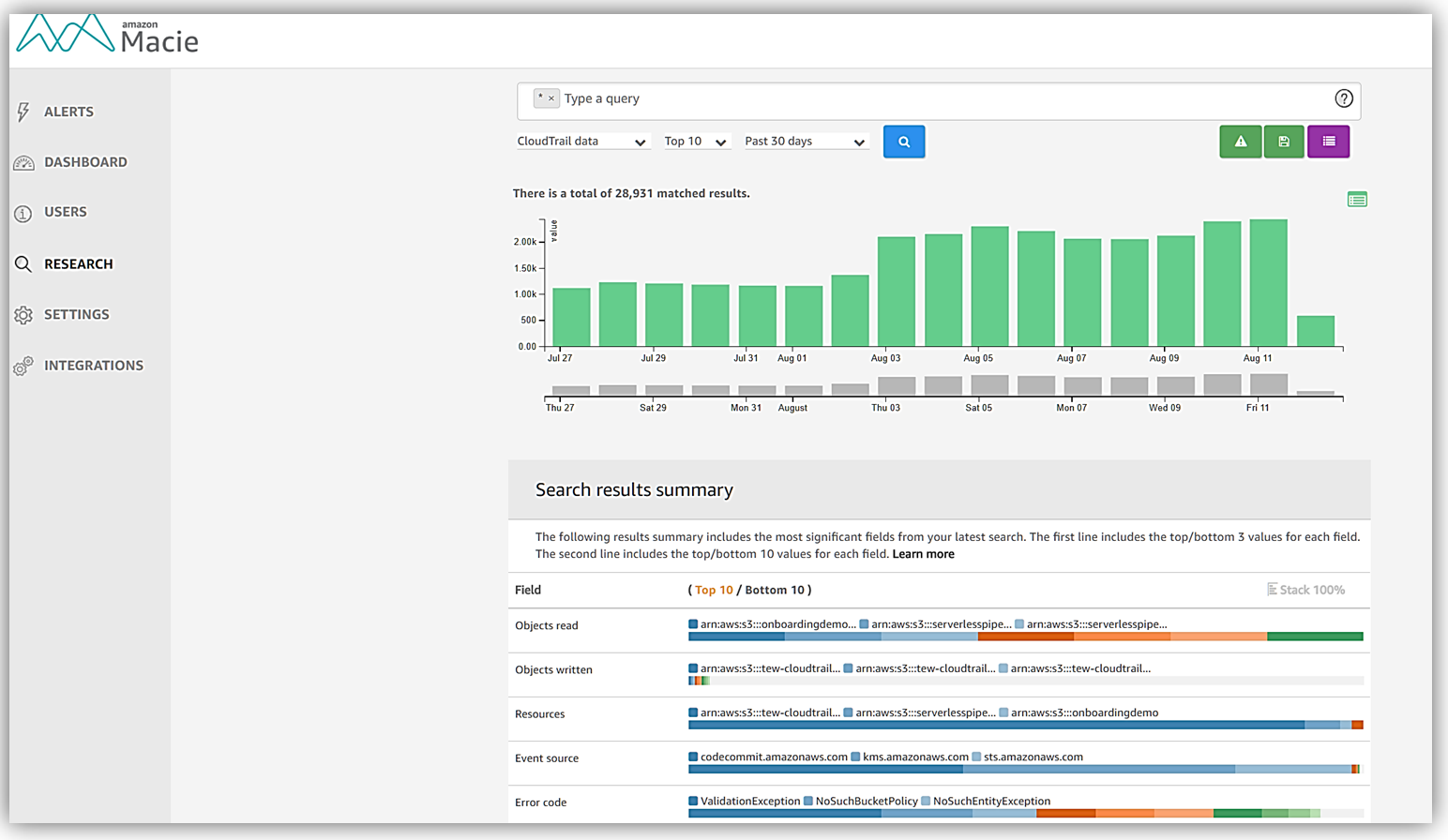
Dashboard Views – views to display various points of the monitored data and activity:
- S3 objects for a selected time range
- S3 objects
- S3 objects by personally identifiable information (PII)
- S3 objects by ACL
- CloudTrail events and associated users
- CloudTrail errors and associated users
- Activity location
- AWS CLoudTrail events
- Activity ISPs
- AWS CloudTrail user identity types
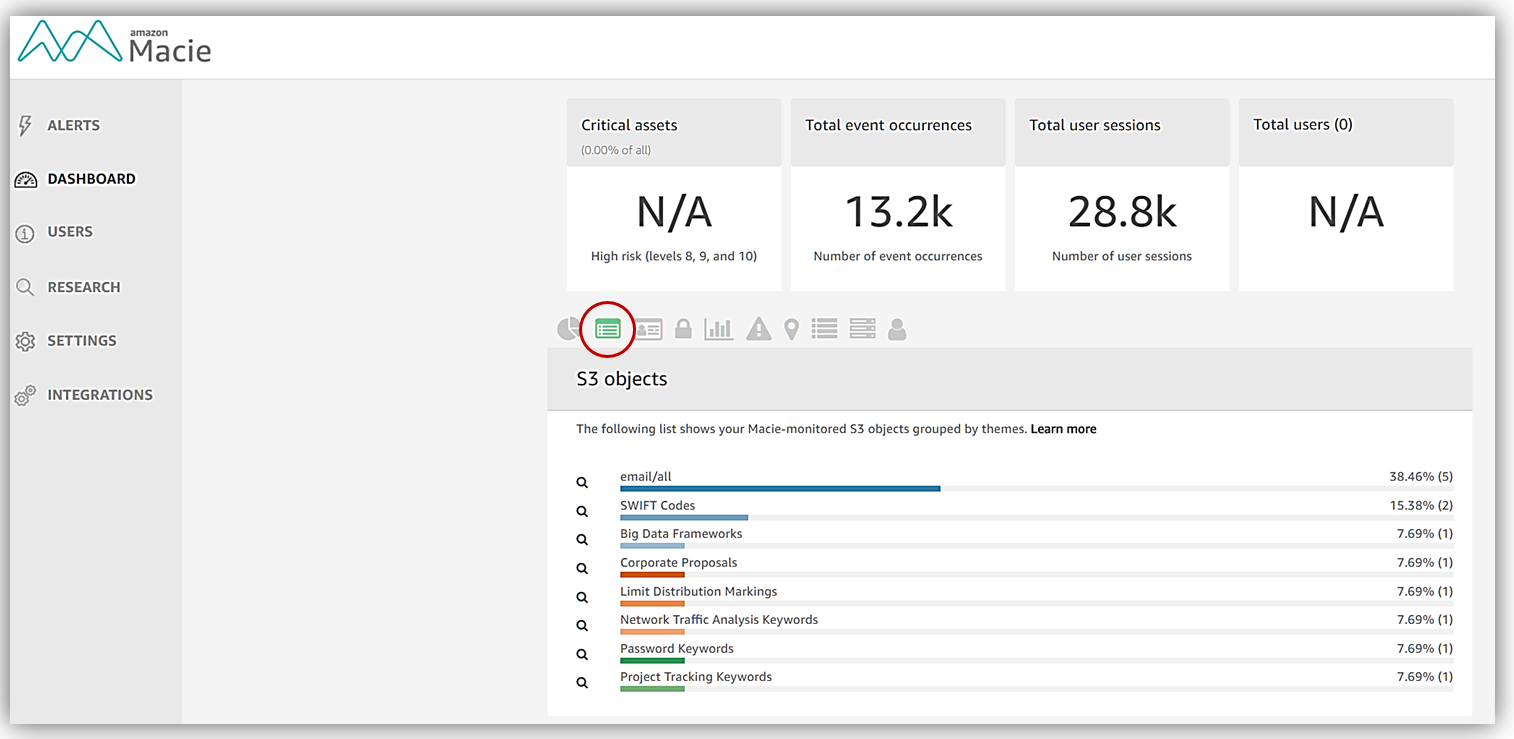
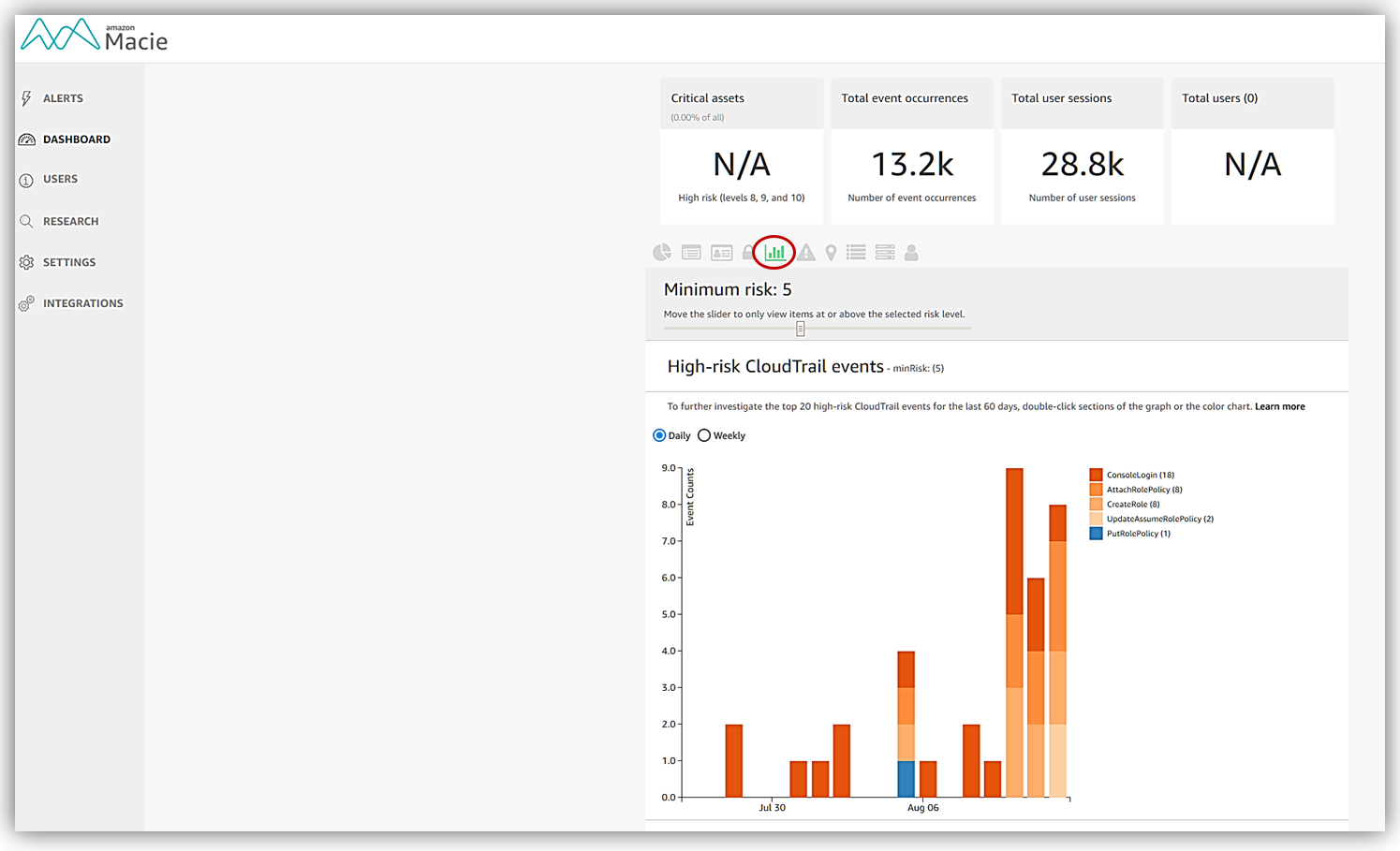
Summary
Well, that concludes our tour of the new and exciting service. Amazon Macie is a sensational new service that uses the power of machine learning and deep learning to aid you in securing, identifying, and protecting your data stored in Amazon S3. Using natural language processing (NLP) to automate data classification, enables you to easily get started with high accuracy classification and immediate protection of your data by simply enabling the service. The interactive dashboards give visibility to the where, what, who, and when of your information allowing you to proactively analyze massive streams of data, data accesses, and API calls in your environment. Learn more about Amazon Macie by visiting the product page or the documentation in the Amazon Macie user guide.
– Tara
相關推薦
Launch – Hello Amazon Macie: Automatically Discover, Classify, and Secure Content at Scale
When Jeff and I heard about this service, we both were curious on the meaning of the name Macie. Of course, Jeff being a great researcher looked u
Discover, classify, and protect sensitive data
Amazon Macie is a security service that uses machine learning to automatically discover, classify, and protect sensitive data in AWS. Amazon Mac
On SDK version 23 and up, your app data will be automatically backed up and restored on app install.
導致這樣的問題是你的menifest檔案中的application 中android:allowBackup=“true”; allowBackup安全風險描述: Android API Level 8及其以上Android系統提供了為應用程式資料的備份和恢復功能,此功能的開關決定於該應
Beyond text: How Spokata uses Amazon Polly to make news and information universally accessible as real
This is a guest blog post by Zack Sherman, Founder of Spokata. In their own words, “Spokata is a mobile audio platform that streams real-time news
Best deals for Oct. 16: Xbox One S, Nintendo Switch games, Amazon Fire TV Stick 4K, and more on sale
If you have ever felt the shoulder ache brought on by too much gaming, have an indent permanently worn into your couch in your "spot," or have ever blown o
Edmunds Amazon Macie Case Study
By taking advantage of Macie, Edmunds can better discover, classify, and protect its data, giving administrators actionable information about p
Launch an Amazon EMR Cluster in a VPC Environment
Amazon Web Services is Hiring. Amazon Web Services (AWS) is a dynamic, growing business unit within Amazon.com. We are currently hiring So
Simple and Secure User Sign Up & Sign In | Amazon Web Services (AWS)
Easy integration with your app With a built-in UI and easy configuration for federating identity providers, you can integrate Amaz
Edmunds Amazon Macie 사례 연구
Edmunds는 Macie를 통해 데이터 검색, 분류 및 보호 기능을 향상시켜 관리자에게 잠재적인 위협에 대한 실질적인 정보를 제공할 수 있습니다. Edmunds는 다양한 분산 환경을 갖추고 있으며 Macie는 감지하기 어려운 항목을 표시하는 자동 돋보기
How to Break a Monolith Application into Microservices with Amazon Elastic Container Service, Docker, and Amazon EC2
Traditional monolithic architectures are hard to scale. As an application's code base grows, it becomes complex to update and maintain.
Amazon Linux 2 – Modern, Stable, and Enterprise-Friendly
I’m getting ready to wrap up my work for the year, cleaning up my inbox and catching up on a few recent AWS launches that happened at and shortly
Build More Reliable and Secure Windows Services Using Amazon Kinesis Agent for Microsoft Windows
We’ve all been there. You’ve deployed a new service on Windows servers. Maybe it’s based on Microsoft technology such as IIS, AD, DHCP, Microsoft
Edmunds の Amazon Macie 匯入事例
Edmunds は Macie を利用することで、データの検出、分類、および保護の効率を向上し、管理者に潛在的な脅威の対処に役立つ情報を提供できます。Edmunds は多様な分散環境を使用しており、Macie は自動拡大鏡として、他の方法では気付きにくい點を明確にします。さらに、Mac
Amazon Macie
In this pricing example, you enable 15 Amazon S3 buckets containing a total of 100 GB of data. After the initial classification, 6GB of new data
Amazon Macie 雲安全-基於機器學習的資料安全服務
Amazon Macie 是一種安全服務,可通過機器學習自動發現、分類和保護 AWS 中的敏感資料。Amazon Macie 可識別個人身份資訊 (PII) 或智慧財產權等敏感資料,併為您提供控制面板和警報,使您可以看到這些資料是如何被訪問或移動的。這一完全託管的服務可持續監控資料訪問活
Edmunds Amazon Macie 案例研究
在 Macie 的幫助下,Edmunds 可以更好地發現、分類和保護其資料,為管理員提供有關潛在威脅的可操作資訊。Edmunds 擁有多樣化的分散式環境,而 Macie 則像放大鏡那樣自動展示出以其他方式難以察覺的細節。此外,Macie 還為 Edmunds 帶來了即時性和長期性優勢。
Amazon re:Invent Preview: RockSet and Yottascale take their bows
With re:Invent dominating the airwaves this week, Amazon's announcements will understandably garner the spotlight. But behind the scenes, some of the most
Node.js: Extend and Maintain Applications + large scale
ice node-js cati tran mysql- ood tin -c spa https://blog.risingstack.com/node-js-mysql-example-handling-hundred-gigabytes-of-data/ My se
Android Developers Blog: Providing a safe and secure experience for our users
Posted by Paul Bankhead, Director, Product Management, Google Play We focus relentlessly on security and privacy on the Google Play Store to ensure An
Airbnb Engineering and Data Science at KDD 2018
The 2018 KDD conference is right around the corner — and we are looking forward to seeing you there. (That’s Knowledge Discovery and Data Mining, if you’re
